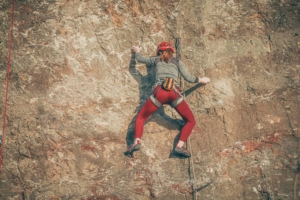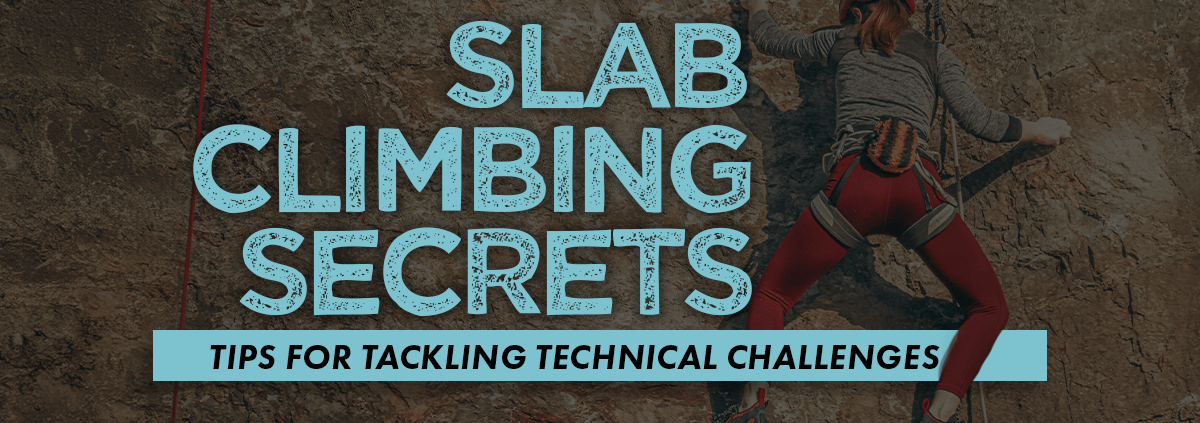Slab Climbing Secrets: Tips for Tackling Technical Challenges
If rock climbing is a dance on the wall, slab climbing is the Grand Ballet, requiring excellent technique, determination, and bravery.
What defines slab climbing compared to other styles? A slab is a section of wall that is less steep than vertical. Because of the less aggressive wall angle, slab climbs often feature smaller or flatter hands and feet. Learning to pirouette your way up a slab climb is a challenging feat. Still, there are some secrets that professional slab experts like Anna Hazelnutt use to conquer these technical challenges.
Since keeping secrets isn’t very nice, this article will unveil the tricks of the trade. Slab climbing, with its fun, exciting, and creatively and physically engaging nature, is a challenge that every climber can take on, regardless of their level. The key to any good secret lies in simplicity and practicality. The four slab climbing secrets covered here are broken down with easy-to-follow cues to help you execute on the wall. The secrets start with smearing and maximizing rubber contact.
Slab Climbing Tips and Tricks
Maximizing Rubber Contact with the wall when smearing.
Climbing shoes have rubber soles to increase friction between you and the wall. Often, slab boulders or slab sections on routes require you to smear (using only the wall or a volume for your feet instead of a hold) against the wall. At first, standing on the wall with no footholds is intimidating. It may seem impossible. But thanks to the rubber soles and physics concept of friction, it’s possible and more useful than meets the eye.
The two keys to remember are to maximize the contact of your sole with the wall and keep tension in your feet! A mental cue for surface area maximization is “heels down, butt out.” Contrary to other types of climbing where having your hips close to the wall is helpful, you’ll want to push your butt away from the wall so it’s easier to put pressure into the wall with your feet (if you’re into weight training, think of the mechanics of a seated leg press). Dropping your heels increases the contact of the ball of your foot with the all and helps you keep tension. Taking baby steps up the wall is critical to maintaining that tension through your feet. If you try to take a too-big step, your other foot will likely slip.
Next on the list of secret tips is edging and counterbalancing your weight.
Edging
 A technique where you place the instep of your foot on a hold so that your toe points perpendicular to the wall and your hip opens. Getting into this position is essential for shifting all your weight over and onto that foot. Many times, slab climbs have inadequate handholds. This forces you to rely heavily on your ability to keep most or all of your weight on your feet. To use a foot edging on hold, you drive your knee past your toes and aim to stand up over your foot. The most evident example of this movement would be a high step. If you’ve successfully shifted your weight into the foot, you should be able to go no-hands.
A technique where you place the instep of your foot on a hold so that your toe points perpendicular to the wall and your hip opens. Getting into this position is essential for shifting all your weight over and onto that foot. Many times, slab climbs have inadequate handholds. This forces you to rely heavily on your ability to keep most or all of your weight on your feet. To use a foot edging on hold, you drive your knee past your toes and aim to stand up over your foot. The most evident example of this movement would be a high step. If you’ve successfully shifted your weight into the foot, you should be able to go no-hands.
Counterbalancing
Another trick to dancing up climbs with few handholds. You can use your arms and legs to balance your center of gravity. If you’ve ever watched gymnasts on the balance beam, you’ve seen this in action. In a scenario where there is only one hand and foothold accessible, you can flag (extend) the leg, not standing on hold to keep you from tipping too far in anyone’s direction as you shift on the planted foot to progress through the next section of the climb.
The final secret addresses the advantages of flexibility and strength.
Flexibility and Strength
If you haven’t picked up on it yet, slab climbing relies more on your legs than your arms. Strengthening the hip flexors and quads is essential for high stepping and edging your way through holds. Flexibility in the hamstrings makes opening your hips and controlling leg movements easier. If you lack the range of motion, you may find yourself swinging your leg out/up to the next foothold, generating unwanted momentum that threatens to throw you off the climb. Greater strength and flexibility lend to control and accuracy in movements, which are essential in a style of climbing that favors the tortoise over the hare. Flexible calves also help drop your heels (see ‘Maximizing Rubber Contact with the Wall When Smearing’).
There it is, the slab climbing secrets laid bare. Now, you can confidently tackle technical challenges like a pro. Elevate the dance of scaling slanted boulders by keeping your butt out and heels down, edging on footholds, and counterbalancing your weight like a gymnast on a balance beam. Improve the strength and flexibility of your leg and hip muscles for more controlled movements, embracing the tortoise’s role in the race to the send. Through it all, have fun and be brave. Slab climbing is fun, and a challenge awaits you if you dare to try it!



